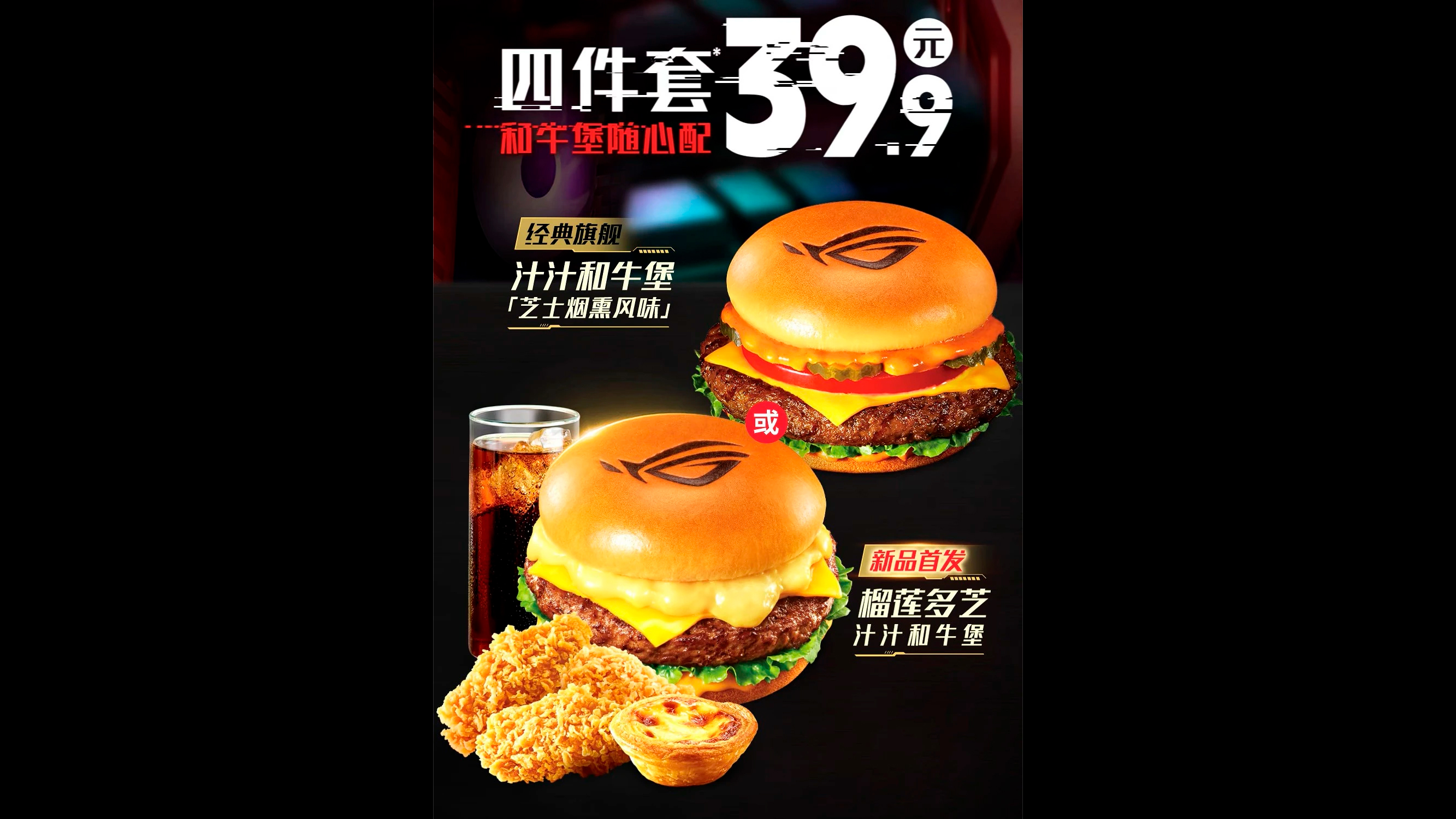Asus makes branded burgers with KFC China, meal deal includes free limited-edition keycaps — ‘Fortress of Faith’ collaboration with fast food chain launches with $5.60 combo
The fastest way to a gamer's heart is through their stomachs.

Tech giant Asus has teamed up with KFC China to create two new menu items as part of its ‘Fortress of Faith’ campaign in the country. According to ITHome [machine translated], each burger comes inside a special, branded box, so everyone can see that you have something special on your tray. Additionally, the ROG logo is burned right into the top bun to remind you that you're eating a top-of-the-line burger made from Wagyu beef.
KFC China is offering two meal items: a four-piece meal set with the burger, some fried chicken, an egg tart, and a drink for 39.90 Yuan (about $5.60 at the current exchange rate) or a similar set that comes with a limited-edition keycap set for 42.90 Yuan (about $5.99).
You’re not getting short-changed with the burger, too, as it includes 120 grams (about a quarter of a pound) of meat, a special durian sauce, cheese, greens, and your usual burger condiments, and is called the Durian Multi-Cheese Juicy Wagyu Burger. If you’re not a fan of durian, you can also get the same promo with the Classic Wagyu Burger – Smokey Cheese Flavor. ITHome reports that the burgers have been in high demand despite launching only today, and that a few restaurants have already sold out.
キーキャップ付きハッPセットあんのか【ROG×KFC联名】ROG居然真的联动到美食界了?https://t.co/hfFZhxhoME pic.twitter.com/EUstUxRmvJJune 27, 2025
This isn’t the first time that a gaming tech company has partnered with a restaurant (or vice-versa) to market their brand. Just last year, Pizza Hut released a pizza warmer designed to sit on top of the PlayStation 5. Although it did not sell the item directly, it made the 3D printing files for it available online for anyone to try. McDonald’s even introduced a McCrispy Gaming Chair that comes with a fry holder and sandwich warmer, ensuring that your food stays warm and you don’t make a mess while spending hours gaming on it.
KFC isn’t new to tech collabs, either. Back in 2020, the fast-food giant built the KFConsole — an Intel NUC PC based on a modified Cooler Master MasterCase NC100, designed to resemble a bucket for holding chicken (and comes with its own chicken chamber). You could get it with up to an Intel Core i9-9980HK CPU, an Nvidia RTX GPU, and 1 TB of NVMe storage. While today’s promo isn’t as wild as these earlier examples, it still shows that food brands recognize that they can connect with gamers through their stomachs.
Follow Tom's Hardware on Google News to get our up-to-date news, analysis, and reviews in your feeds. Make sure to click the Follow button.
Get Tom's Hardware's best news and in-depth reviews, straight to your inbox.

Jowi Morales is a tech enthusiast with years of experience working in the industry. He’s been writing with several tech publications since 2021, where he’s been interested in tech hardware and consumer electronics.
-
usertests Reply
https://en.wikipedia.org/wiki/KFC_in_Chinahttps://hbr.org/2011/11/kfcs-radical-approach-to-chinajlake3 said:Huh.
I'm still back on the part where KFC is selling cheeseburgers.One of the most impressive stories of a U.S. multinational in an emerging market is unfolding right now in China: KFC is opening one new restaurant a day, on average (on a base of some 3,300), with the intention of reaching 15,000 outlets. The company has achieved this success by abandoning the dominant logic behind its growth in the United States: a limited menu, low prices, and an emphasis on takeout.
KFC China’s menus typically include 50 items, compared with about 29 in the United States. The menu variety adds traffic and encourages repeat visits. The company introduces about 50 new products a year (some of them are offered only temporarily), compared with one or two in the U.S. Its executives have what they consider to be a very aggressive program for new product development, which is handled by a committee of managers from marketing, operations, product safety, and the supply chain. Menus offer spicy chicken, rice dishes, soy milk drinks, egg tarts, fried dough sticks, wraps with local sauces, and fish and shrimp burgers on fresh buns.
It's a big phenomenon in China, and empowered to do whatever it takes to appeal to customers. It's hard to say how cheeseburgers fit into a localization strategy, but they already offered seafood burgers and this is Wagyu beef and a temporary promotional item.